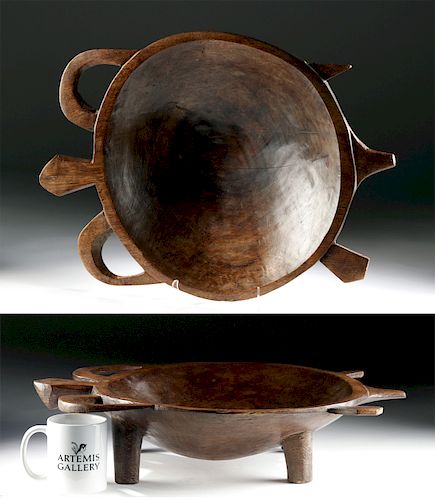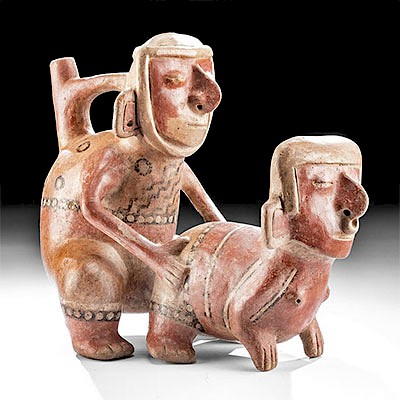Rare 19th C. Fijian Wood Kava Bowl - Sea Turtle Form
Lot 85a
About Seller
Artemis Fine Arts
686 S Taylor Ave, Ste 106
Louisville, CO 80027
United States
Selling antiquities, ancient and ethnographic art online since 1993, Artemis Gallery specializes in Classical Antiquities (Egyptian, Greek, Roman, Near Eastern), Asian, Pre-Columbian, African / Tribal / Oceanographic art. Our extensive inventory includes pottery, stone, metal, wood, glass and textil...Read more
Estimate:
$1,400 - $2,100
Absentee vs Live bid
Two ways to bid:
- Leave a max absentee bid and the platform will bid on your behalf up to your maximum bid during the live auction.
- Bid live during the auction and your bids will be submitted real-time to the auctioneer.
Bid Increments
| Price | Bid Increment |
|---|---|
| $0 | $25 |
| $300 | $50 |
| $1,000 | $100 |
| $2,000 | $250 |
| $5,000 | $500 |
| $10,000 | $1,000 |
| $20,000 | $2,500 |
| $50,000 | $5,000 |
| $100,000 | $10,000 |
| $200,000 | $20,000 |
About Auction
By Artemis Fine Arts
Jan 30, 2020
Set Reminder
2020-01-30 10:00:00
2020-01-30 10:00:00
America/New_York
Bidsquare
Bidsquare : Pre-Columbian | Tribal | Ethnographic
https://www.bidsquare.com/auctions/artemis-gallery/pre-columbian-tribal-ethnographic-4830
Featuring ancient and ethnographic art from around the world, including Pre-Columbian, Native American, African / Tribal, Oceanic, Ethnographic, Spanish Colonial, Fossils, Fine Art, much more. Artemis Fine Arts info@artemisgallery.com
Featuring ancient and ethnographic art from around the world, including Pre-Columbian, Native American, African / Tribal, Oceanic, Ethnographic, Spanish Colonial, Fossils, Fine Art, much more. Artemis Fine Arts info@artemisgallery.com
- Lot Description
Oceania, Fiji Islands, Viti Levu Island, ca. 19th century CE. A very rare and lovely bowl, hand-carved from finely grained wood, in the form of a sea turtle supported by four tubular legs and featuring five projecting tabs which double as handles. A knob-form head protrudes from the front of the rim that, aside from a pointed nose, does not present any discernible facial features. The body of the animal has a concave 'shell' that doubles as the basin. Large bowls of this kind (known as darivonu, tanoa or kumete ni yaqona), cut from a single block, were used for the mixing of the psychoactive beverage called kava (kava or kava kava in Tongan; yaqona, pronounced yanggona, in Fijian), made from the stems and roots of the pepper bush Piper methysticum, mixed with water. By the 18th century, the Tongan practice of kava preparation - a chief ritual - spread to eastern and coastal Fiji. Size: 21.375" L x 15.75" W x 5" H (54.3 cm x 40 cm x 12.7 cm).
For a stylistically-similar example without legs, please see The Metropolitan Museum of Art, accession number 1979.206.1579: https://www.metmuseum.org/art/collection/search/313798
Provenance: Tambaran Gallery, New York, New York, USA
All items legal to buy/sell under U.S. Statute covering cultural patrimony Code 2600, CHAPTER 14, and are guaranteed to be as described or your money back.
A Certificate of Authenticity will accompany all winning bids.
We ship worldwide and handle all shipping in-house for your convenience.
#149085Minor abrasions to legs and rim, with several stable hairline fissures, otherwise intact and excellent. Light earthen deposits within some recessed areas, and wonderful patina throughout.Condition
- Shipping Info
-
All shipping is handled in-house for your convenience. Your invoice from Artemis Gallery will include shipping calculation instructions. If in doubt, please inquire BEFORE bidding for estimated shipping costs for individual items.
-
- Buyer's Premium



 EUR
EUR CAD
CAD AUD
AUD GBP
GBP MXN
MXN HKD
HKD CNY
CNY MYR
MYR SEK
SEK SGD
SGD CHF
CHF THB
THB
















